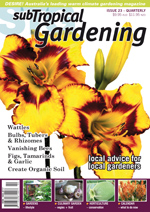Botanical: Ruscus species
Common: Butcher’s Broom
Family: Ruscaceae
It grows well in shade to dappled sunlight and is extremely tolerant of root competition. So much so that it can often be found in older Queensland gardens beneath mature jacaranda and poinciana trees.
Butcher’s Broom is an evergreen shrub-like perennial growing 1 to 1.2m tall.
There are around 20 species of Ruscus and here we review the three most commonly cultivated. The obvious differences are in the leaves (called cladodes) and the flap over the flower.
Ruscus aculeatus – From the Mediterranean regions of Europe. Pinkish-mauve flowers appear on the upper-side of cladodes. Upright ‘stems’ are branched. Shiny green spine-tipped cladodes.
 Ruscus hypoglossum – From Italy, Czechoslovakia and Turkey. Flowers occur on both sides of cladodes. Has a more pronounced second ‘leaf’ (flower bract). Spineless dull green cladodes with a pointed tip. Grows up to 40 cm high. Occasionally grown in the subtropical Australia but more commonly seen in cooler temperate regions of Australia and overseas.
Ruscus hypoglossum – From Italy, Czechoslovakia and Turkey. Flowers occur on both sides of cladodes. Has a more pronounced second ‘leaf’ (flower bract). Spineless dull green cladodes with a pointed tip. Grows up to 40 cm high. Occasionally grown in the subtropical Australia but more commonly seen in cooler temperate regions of Australia and overseas.
 Ruscus hypophyllum – From northwest Africa, Sicily, southeast of France and south of Spain. Flowers appear on both sides of cladodes. Has a less pronounced second flower bract. Spineless shiny green cladodes with a pointed tip. Grows up to 70 cm high. Most widely grown in the subtropical Australia.
Ruscus hypophyllum – From northwest Africa, Sicily, southeast of France and south of Spain. Flowers appear on both sides of cladodes. Has a less pronounced second flower bract. Spineless shiny green cladodes with a pointed tip. Grows up to 70 cm high. Most widely grown in the subtropical Australia.
What appear to be shiny deep green leaves are in fact flattened leaf-like stems or cladodes. People are often amazed to see the small white flowers with violet centres emerging from the centre of these ‘leaves’.. making this a great curiosity garden or pot plant.
For more on these plants, refer to the following issues of subTropical Gardening magazine:
Ruscus aculeatus – 19(9)
Ruscus hypoglossum – 19(9)
Ruscus hypophyllum – 18(77); 19(9)


{ 1 comment… read it below or add one }
It is easy to confuse these plants… look carefully at the flap over the flower, or for R. aculeatus its a case of looking for the branched ‘stems’.
Note: the true stem is an undergound rhizome which means the upright structure commonly referred to as a ‘stem’ which holds the cladodes is actually a modified leaf stalk.